Nicholas P. Cheremisinoff. Handbook of Solid Waste Management and Waste Minimization Technologies
Подождите немного. Документ загружается.

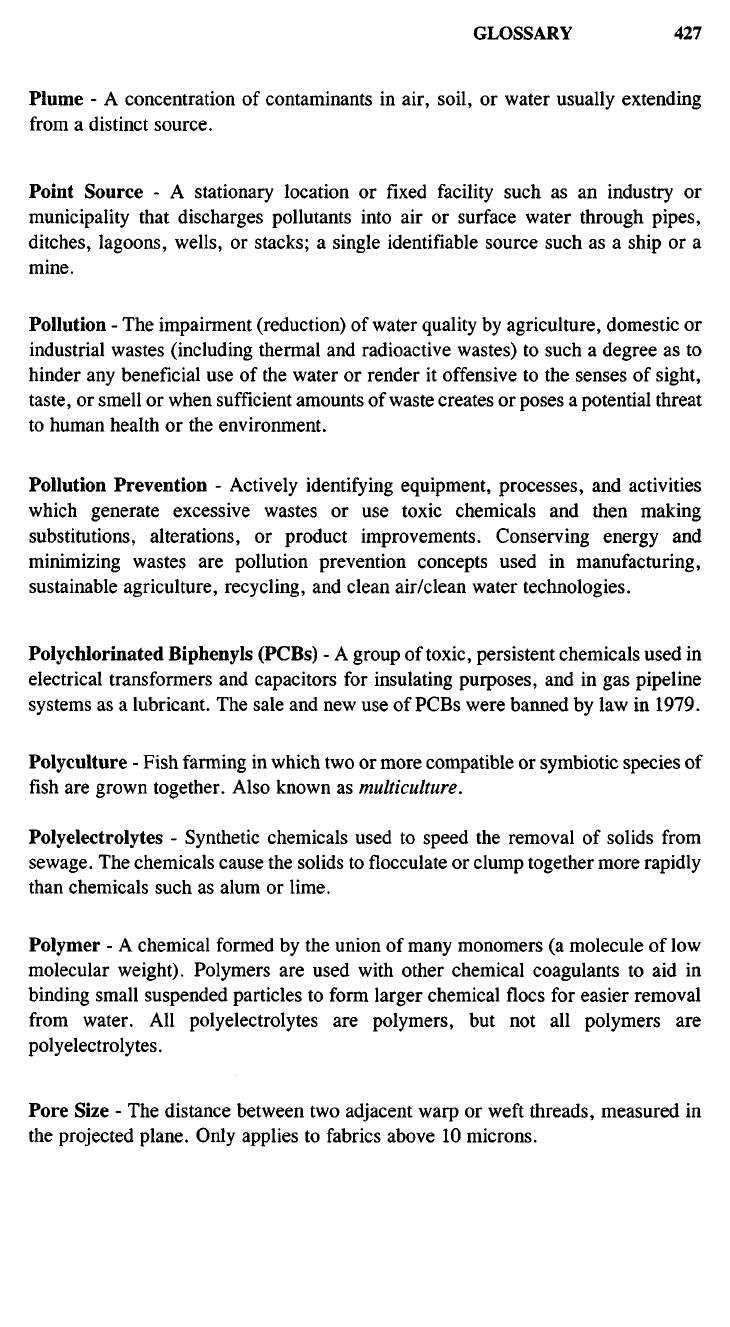
Plume - A concentration of contaminants in air, soil, or water usually extending
from a distinct source.
Point Source - A stationary location or fixed facility such as an industry or
municipality that discharges pollutants into air or surface water through pipes,
ditches, lagoons, wells, or stacks; a single identifiable source such as a ship or a
mine.
Pollution - The impairment (reduction) of water quality by agriculture, domestic or
industrial wastes (including thermal and radioactive wastes) to such a degree as to
hinder any beneficial use of the water or render it offensive to the senses of sight,
taste,
or smell or when sufficient amounts of waste creates or poses a potential threat
to human health or the environment.
Pollution Prevention - Actively identifying equipment, processes, and activities
which generate excessive wastes or use toxic chemicals and then making
substitutions, alterations, or product improvements. Conserving energy and
minimizing wastes are pollution prevention concepts used in manufacturing,
sustainable agriculture, recycling, and clean air/clean water technologies.
Polychlorinated Biphenyls (PCBs) - A group of toxic, persistent chemicals used in
electrical transformers and capacitors for insulating purposes, and in gas pipeline
systems as a lubricant. The sale and new use of PCBs were banned by law in 1979.
Polyculture - Fish farming in which two or more compatible or symbiotic species of
fish are grown together. Also known as multiculture.
Polyelectrolytes - Synthetic chemicals used to speed the removal of solids from
sewage. The chemicals cause the solids to flocculate or clump together more rapidly
than chemicals such as alum or lime.
Polymer - A chemical formed by the union of many monomers (a molecule of low
molecular weight). Polymers are used with other chemical coagulants to aid in
binding small suspended particles to form larger chemical floes for easier removal
from water. All polyelectrolytes are polymers, but not all polymers are
polyelectrolytes.
Pore Size - The distance between two adjacent warp or weft threads, measured in
the projected plane. Only applies to fabrics above 10 microns.
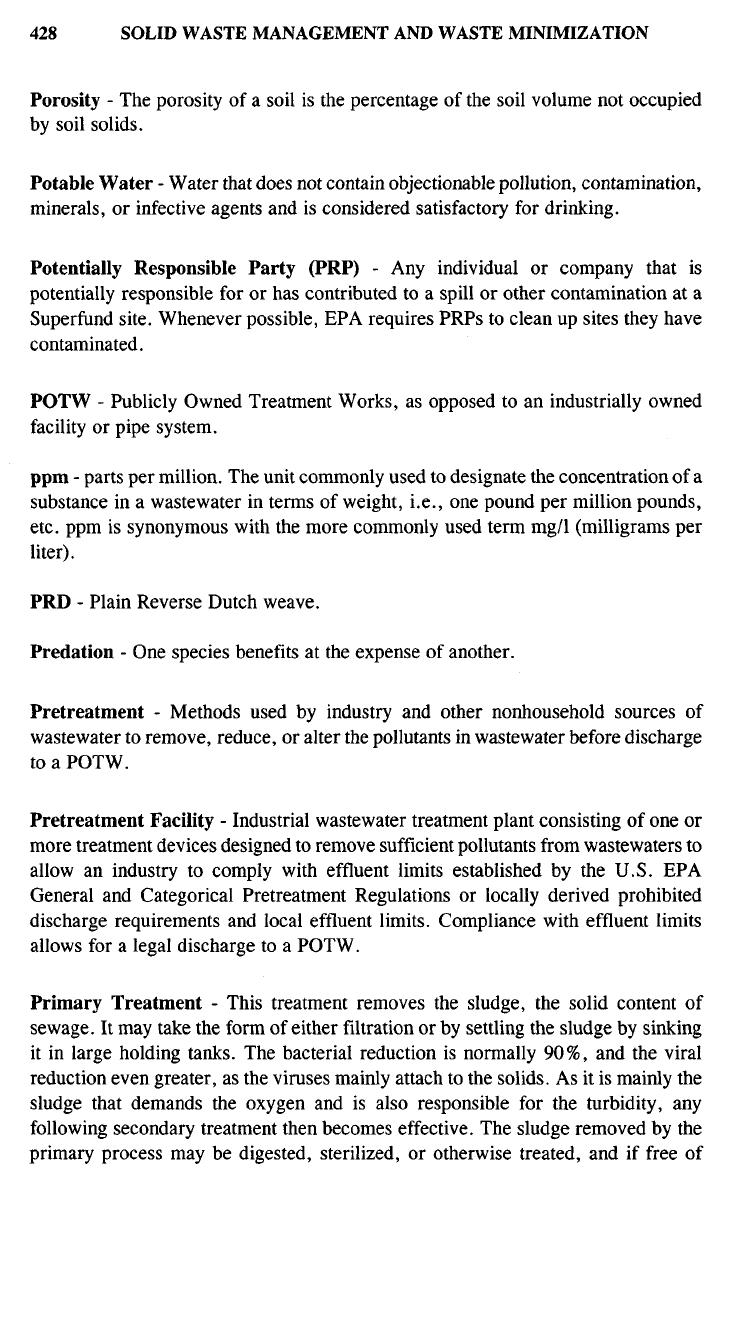
Porosity - The porosity of a soil is the percentage of the soil volume not occupied
by soil solids.
Potable Water - Water that does not contain objectionable pollution, contamination,
minerals, or infective agents and is considered satisfactory for drinking.
Potentially Responsible Party (PRP) - Any individual or company that is
potentially responsible for or has contributed to a spill or other contamination at a
Superfund site. Whenever possible, EPA requires PRPs to clean up sites they have
contaminated.
POTW - Publicly Owned Treatment Works, as opposed to an industrially owned
facility or pipe system.
ppm - parts per million. The unit commonly used to designate the concentration of a
substance in a wastewater in terms of weight, i.e., one pound per million pounds,
etc.
ppm is synonymous with the more commonly used term mg/1 (milligrams per
liter).
PRD - Plain Reverse Dutch weave.
Predation - One species benefits at the expense of another.
Pretreatment - Methods used by industry and other nonhousehold sources of
wastewater to remove, reduce, or alter the pollutants in wastewater before discharge
to a POTW.
Pretreatment Facility - Industrial wastewater treatment plant consisting of one or
more treatment devices designed to remove sufficient pollutants from wastewaters to
allow an industry to comply with effluent limits established by the U.S. EPA
General and Categorical Pretreatment Regulations or locally derived prohibited
discharge requirements and local effluent limits. Compliance with effluent limits
allows for a legal discharge to a POTW.
Primary Treatment - This treatment removes the sludge, the solid content of
sewage. It may take the form of either filtration or by settling the sludge by sinking
it in large holding tanks. The bacterial reduction is normally 90%, and the viral
reduction even greater, as the viruses mainly attach to the solids. As it is mainly the
sludge that demands the oxygen and is also responsible for the turbidity, any
following secondary treatment then becomes effective. The sludge removed by the
primary process may be digested, sterilized, or otherwise treated, and if free of
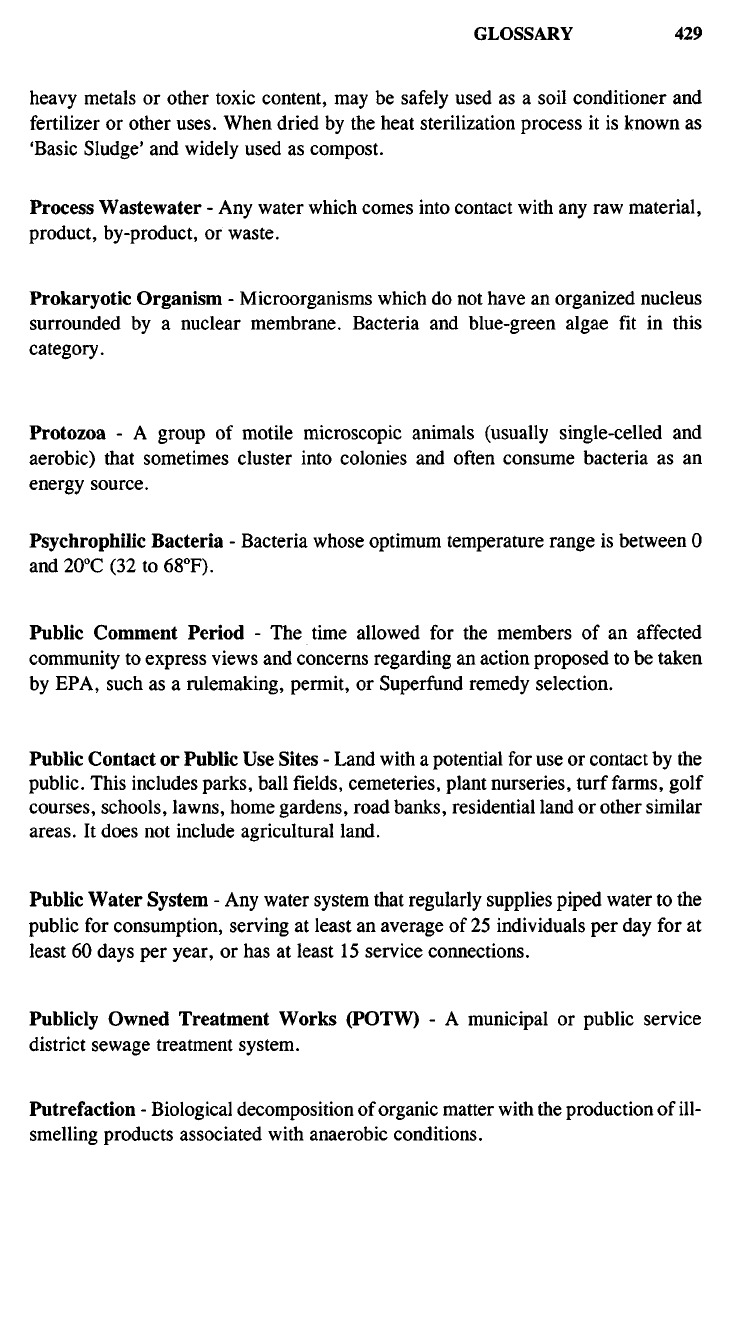
heavy metals or other toxic content, may be safely used as a soil conditioner and
fertilizer or other uses. When dried by the heat sterilization process it is known as
'Basic Sludge' and widely used as compost.
Process Wastewater - Any water which comes into contact with any raw material,
product, by-product, or waste.
Prokaryotic Organism - Microorganisms which do not have an organized nucleus
surrounded by a nuclear membrane. Bacteria and blue-green algae fit in this
category.
Protozoa - A group of motile microscopic animals (usually single-celled and
aerobic) that sometimes cluster into colonies and often consume bacteria as an
energy source.
Psychrophilic Bacteria - Bacteria whose optimum temperature range is between 0
and 2O
0
C (32 to 68
0
F).
Public Comment Period - The time allowed for the members of an affected
community to express views and concerns regarding an action proposed to be taken
by EPA, such as a rulemaking, permit, or Superfund remedy selection.
Public Contact or Public Use Sites - Land with a potential for use or contact by the
public. This includes parks, ball fields, cemeteries, plant nurseries, turf farms, golf
courses, schools, lawns, home gardens, road banks, residential land or other similar
areas.
It does not include agricultural land.
Public Water System - Any water system that regularly supplies piped water to the
public for consumption, serving at least an average of 25 individuals per day for at
least 60 days per year, or has at least 15 service connections.
Publicly Owned Treatment Works (POTW) - A municipal or public service
district sewage treatment system.
Putrefaction - Biological decomposition of organic matter with the production of ill-
smelling products associated with anaerobic conditions.
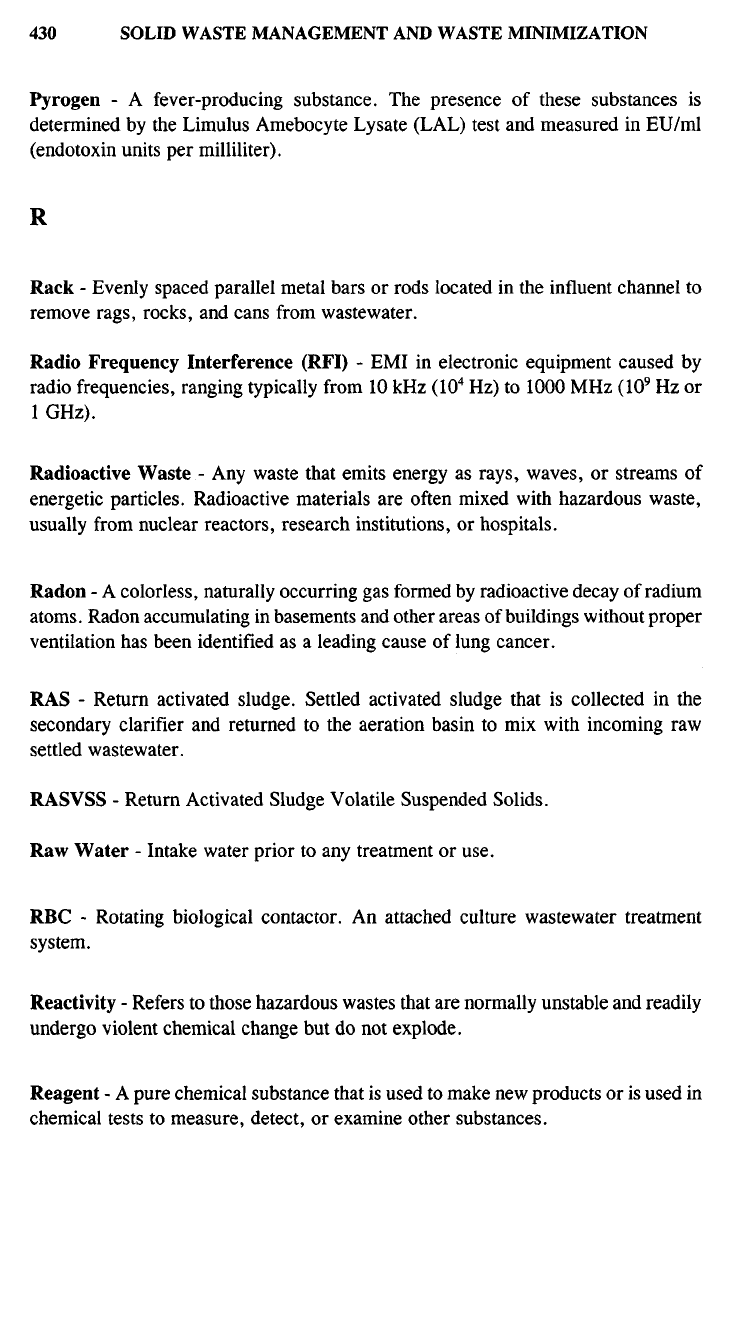
Pyrogen - A fever-producing substance. The presence of these substances is
determined by the Limulus Amebocyte Lysate (LAL) test and measured in EU/ml
(endotoxin units per milliliter).
R
Rack - Evenly spaced parallel metal bars or rods located in the influent channel to
remove rags, rocks, and cans from wastewater.
Radio Frequency Interference (RFI) - EMI in electronic equipment caused by
radio frequencies, ranging typically from 10 kHz (10
4
Hz) to 1000 MHz (10
9
Hz or
1 GHz).
Radioactive Waste - Any waste that emits energy as rays, waves, or streams of
energetic particles. Radioactive materials are often mixed with hazardous waste,
usually from nuclear reactors, research institutions, or hospitals.
Radon - A colorless, naturally occurring gas formed by radioactive decay of radium
atoms. Radon accumulating in basements and other areas of buildings without proper
ventilation has been identified as a leading cause of lung cancer.
RAS - Return activated sludge. Settled activated sludge that is collected in the
secondary clarifier and returned to the aeration basin to mix with incoming raw
settled wastewater.
RASVSS - Return Activated Sludge Volatile Suspended Solids.
Raw Water - Intake water prior to any treatment or use.
RBC - Rotating biological contactor. An attached culture wastewater treatment
system.
Reactivity - Refers to those hazardous wastes that are normally unstable and readily
undergo violent chemical change but do not explode.
Reagent - A pure chemical substance that is used to make new products or is used in
chemical tests to measure, detect, or examine other substances.
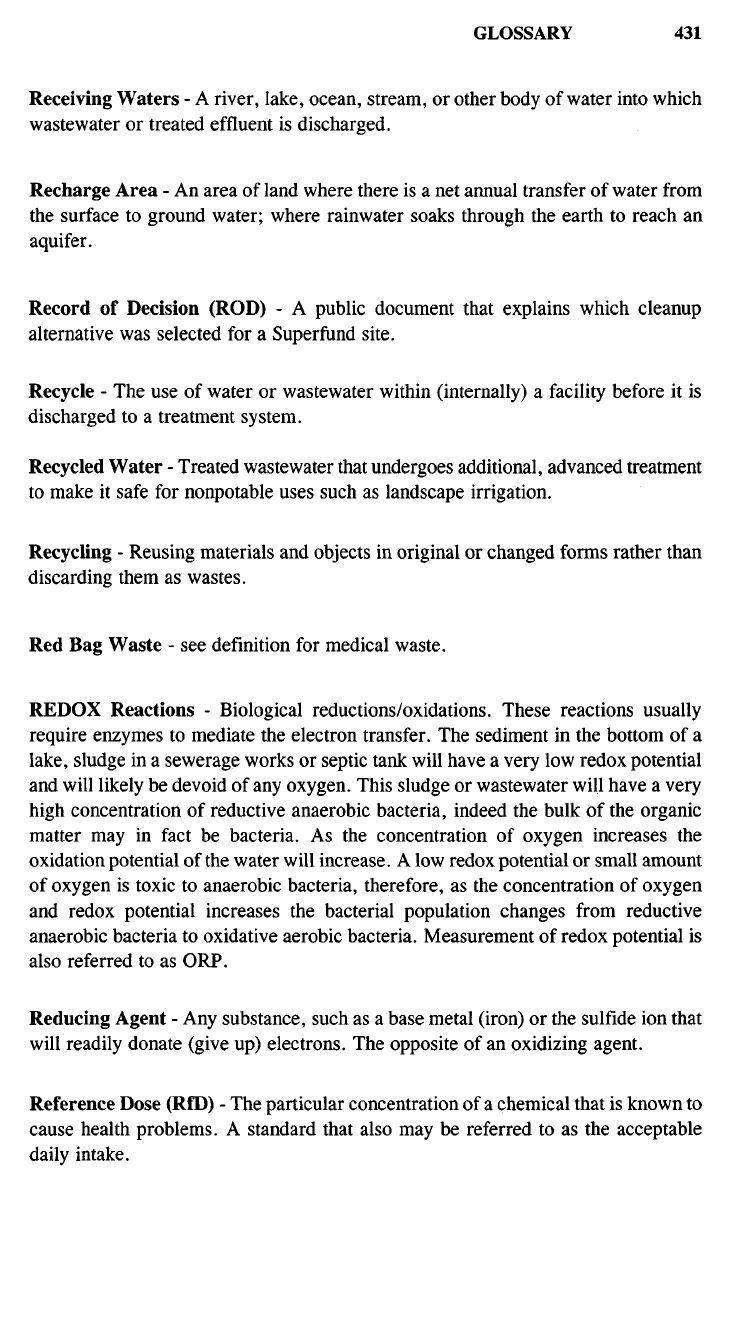
Receiving Waters - A river, lake, ocean, stream, or other body of water into which
waste water or treated effluent is discharged.
Recharge Area - An area of land where there is a net annual transfer of water from
the surface to ground water; where rainwater soaks through the earth to reach an
aquifer.
Record of Decision (ROD) - A public document that explains which cleanup
alternative was selected for a Superfund site.
Recycle - The use of water or wastewater within (internally) a facility before it is
discharged to a treatment system.
Recycled Water - Treated wastewater that undergoes additional, advanced treatment
to make it safe for nonpotable uses such as landscape irrigation.
Recycling - Reusing materials and objects in original or changed forms rather than
discarding them as wastes.
Red Bag Waste - see definition for medical waste.
REDOX Reactions - Biological reductions/oxidations. These reactions usually
require enzymes to mediate the electron transfer. The sediment in the bottom of a
lake,
sludge in a sewerage works or septic tank will have a very low redox potential
and will likely be devoid of any oxygen. This sludge or wastewater will have a very
high concentration of reductive anaerobic bacteria, indeed the bulk of the organic
matter may in fact be bacteria. As the concentration of oxygen increases the
oxidation potential of the water will increase. A low redox potential or small amount
of oxygen is toxic to anaerobic bacteria, therefore, as the concentration of oxygen
and redox potential increases the bacterial population changes from reductive
anaerobic bacteria to oxidative aerobic bacteria. Measurement of redox potential is
also referred to as ORP.
Reducing Agent - Any substance, such as a base metal (iron) or the sulfide ion that
will readily donate (give up) electrons. The opposite of an oxidizing agent.
Reference Dose (RfD) - The particular concentration of a chemical that is known to
cause health problems. A standard that also may be referred to as the acceptable
daily intake.
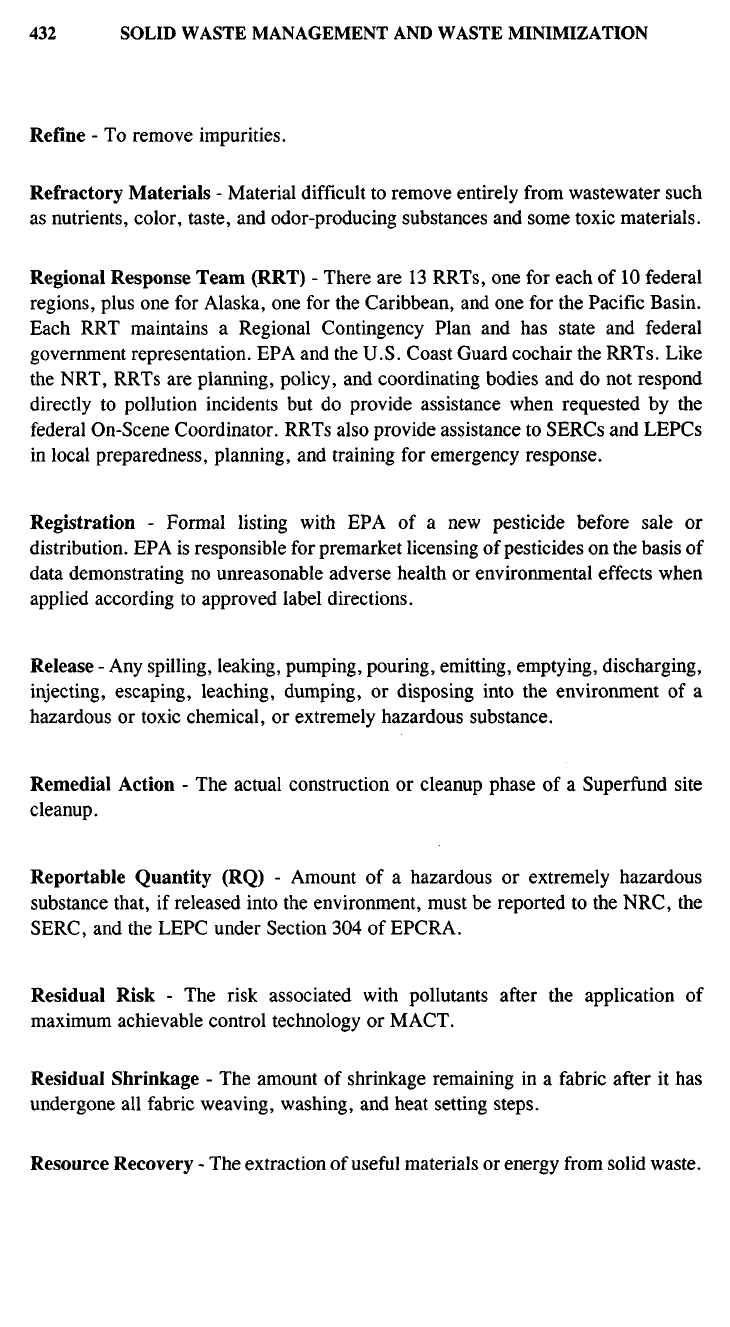
Refine - To remove impurities.
Refractory Materials - Material difficult to remove entirely from wastewater such
as nutrients, color, taste, and odor-producing substances and some toxic materials.
Regional Response Team (RRT) - There are 13 RRTs, one for each of 10 federal
regions, plus one for Alaska, one for the Caribbean, and one for the Pacific Basin.
Each RRT maintains a Regional Contingency Plan and has state and federal
government representation. EPA and the U.S. Coast Guard cochair the RRTs. Like
the NRT, RRTs are planning, policy, and coordinating bodies and do not respond
directly to pollution incidents but do provide assistance when requested by the
federal On-Scene Coordinator. RRTs also provide assistance to SERCs and LEPCs
in local preparedness, planning, and training for emergency response.
Registration - Formal listing with EPA of a new pesticide before sale or
distribution. EPA is responsible for premarket licensing of pesticides on the basis of
data demonstrating no unreasonable adverse health or environmental effects when
applied according to approved label directions.
Release - Any spilling, leaking, pumping, pouring, emitting, emptying, discharging,
injecting, escaping, leaching, dumping, or disposing into the environment of a
hazardous or toxic chemical, or extremely hazardous substance.
Remedial Action - The actual construction or cleanup phase of a Superfund site
cleanup.
Reportable Quantity (RQ) - Amount of a hazardous or extremely hazardous
substance that, if released into the environment, must be reported to the NRC, the
SERC, and the LEPC under Section 304 of EPCRA.
Residual Risk - The risk associated with pollutants after the application of
maximum achievable control technology or MACT.
Residual Shrinkage - The amount of shrinkage remaining in a fabric after it has
undergone all fabric weaving, washing, and heat setting steps.
Resource Recovery - The extraction of useful materials or energy from solid waste.
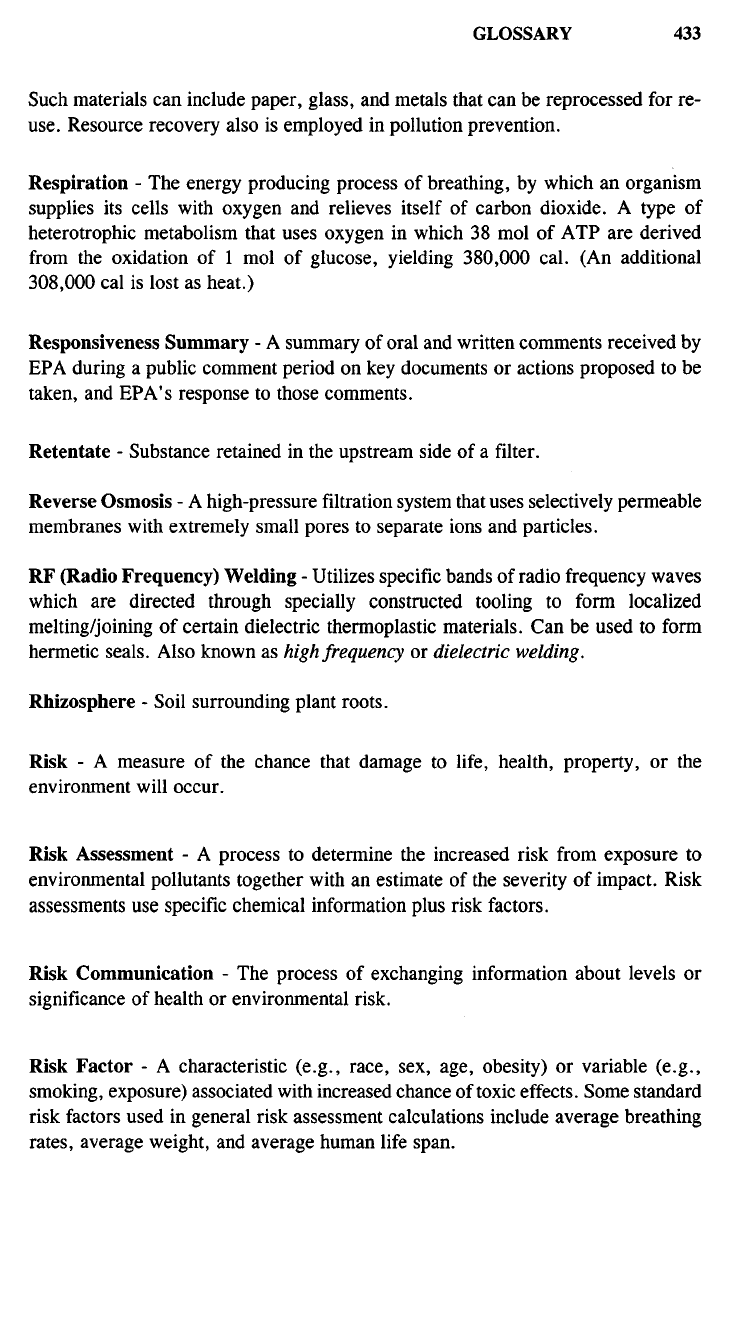
Such materials can include paper, glass, and metals that can be reprocessed for re-
use.
Resource recovery also is employed in pollution prevention.
Respiration - The energy producing process of breathing, by which an organism
supplies its cells with oxygen and relieves itself of carbon dioxide. A type of
heterotrophic metabolism that uses oxygen in which 38 mol of ATP are derived
from the oxidation of 1 mol of glucose, yielding 380,000 cal. (An additional
308,000 cal is lost as heat.)
Responsiveness Summary - A summary of oral and written comments received by
EPA during a public comment period on key documents or actions proposed to be
taken, and EPA's response to those comments.
Retentate - Substance retained in the upstream side of a filter.
Reverse Osmosis - A high-pressure filtration system that uses selectively permeable
membranes with extremely small pores to separate ions and particles.
RF (Radio Frequency) Welding - Utilizes specific bands of radio frequency waves
which are directed through specially constructed tooling to form localized
melting/joining of certain dielectric thermoplastic materials. Can be used to form
hermetic seals. Also known as high frequency or dielectric welding.
Rhizosphere - Soil surrounding plant roots.
Risk - A measure of the chance that damage to life, health, property, or the
environment will occur.
Risk Assessment - A process to determine the increased risk from exposure to
environmental pollutants together with an estimate of the severity of impact. Risk
assessments use specific chemical information plus risk factors.
Risk Communication - The process of exchanging information about levels or
significance of health or environmental risk.
Risk Factor - A characteristic (e.g., race, sex, age, obesity) or variable (e.g.,
smoking, exposure) associated with increased chance of toxic effects. Some standard
risk factors used in general risk assessment calculations include average breathing
rates,
average weight, and average human life span.

R/O Unit - Reverse osmosis unit for water purification in small aquariums and
miniature yard ponds, utilizes a membrane under pressure to filter dissolved solids
and pollutants from the water. Two different filter membranes can be used: the CTA
(cellulose triacetate) membrane is less expensive, but only works with chlorinated
water and removes 50 to 70% of nitrates, and the TFC membrane, which is more
expensive, removes 95% of nitrates, but is ruined by chlorine. R/O wastes water
and a system that cleans 100 gallons a day will cost from $400 to $600 with
membrane replacement adding to the cost. A unit that handles 140 gallons a day will
cost above $700.
Rodenticide - A pesticide or other agent used to kill rats and other rodents or to
prevent them from damaging food, crops, or forage.
Roof Leader - The roof leader (or downspout) conveys runoff that has been
collected in eavestroughs from roof tops, down to the ground surface or to a
receiving sewer service.
Rotary Scrubber - A device that separates particulate contamination from a gas
stream by impaction onto a wet rotor or into a fine spray of scrubbing liquor.
Rotating Biological Contactor - An aerobic treatment system that rotates plastic
media with fixed microbial film alternately through liquid effluent and air to reduce
the BOD value.
Routine Storage - The storage of biosolids (for extended periods of time) until the
land is in a condition to receive the biosolids.
RR - Respiration rate - the weight of oxygen utilized by the total weight of MLSS in
a given time.
Runoff - Water running down slopes rather than sinking in (again, result of poor
humus content), e.g., erosion due to deforestation.
s
Salts - The minerals that water picks up as it passes through the air, over and under
the ground, and through household and industrial uses.
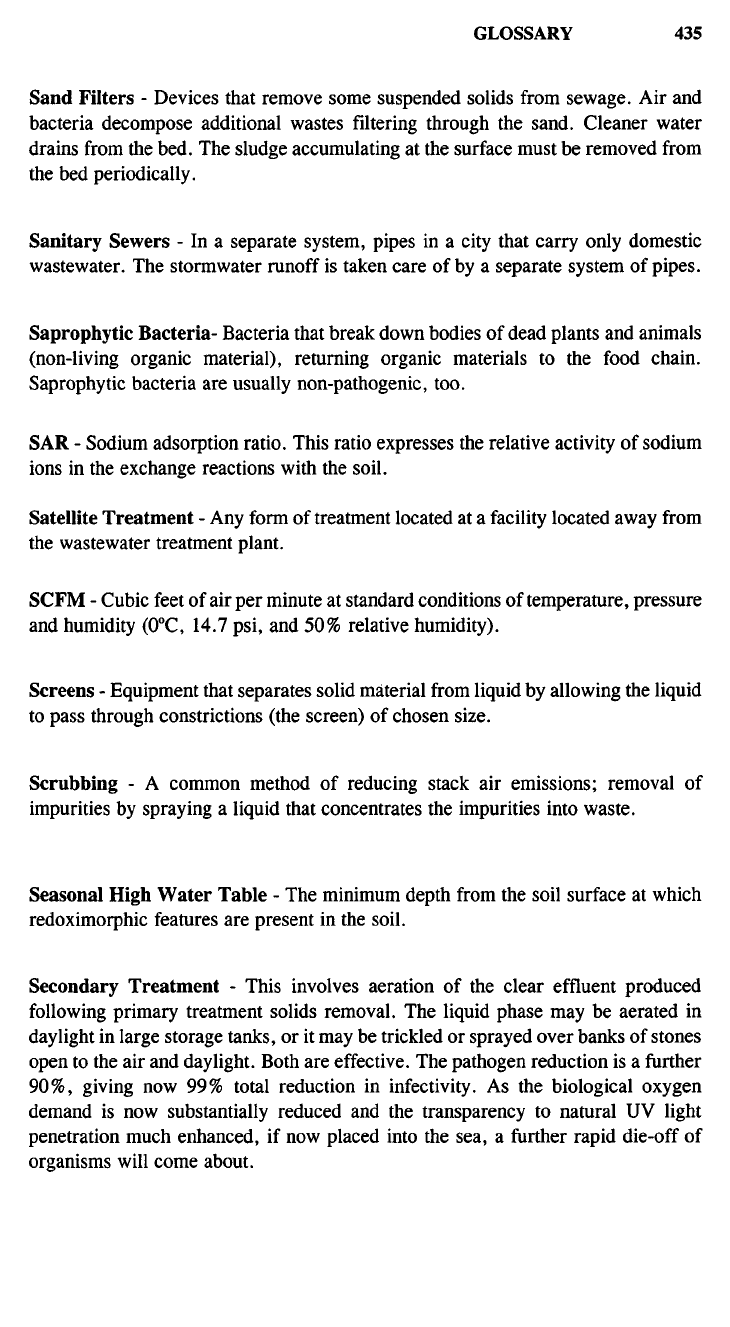
Sand Filters - Devices that remove some suspended solids from sewage. Air and
bacteria decompose additional wastes filtering through the sand. Cleaner water
drains from the bed. The sludge accumulating at the surface must be removed from
the bed periodically.
Sanitary Sewers - In a separate system, pipes in a city that carry only domestic
wastewater. The stormwater runoff is taken care of by a separate system of pipes.
Saprophytic Bacteria- Bacteria that break down bodies of dead plants and animals
(non-living organic material), returning organic materials to the food chain.
Saprophytic bacteria are usually non-pathogenic, too.
SAR - Sodium adsorption ratio. This ratio expresses the relative activity of sodium
ions in the exchange reactions with the soil.
Satellite Treatment - Any form of treatment located at a facility located away from
the wastewater treatment plant.
SCFM - Cubic feet of air per minute at standard conditions of temperature, pressure
and humidity (O
0
C, 14.7 psi, and 50% relative humidity).
Screens - Equipment that separates solid material from liquid by allowing the liquid
to pass through constrictions (the screen) of chosen size.
Scrubbing - A common method of reducing stack air emissions; removal of
impurities by spraying a liquid that concentrates the impurities into waste.
Seasonal High Water Table - The minimum depth from the soil surface at which
redoximorphic features are present in the soil.
Secondary Treatment - This involves aeration of the clear effluent produced
following primary treatment solids removal. The liquid phase may be aerated in
daylight in large storage tanks, or it may be trickled or sprayed over banks of stones
open to the air and daylight. Both are effective. The pathogen reduction is a further
90%,
giving now 99% total reduction in infectivity. As the biological oxygen
demand is now substantially reduced and the transparency to natural UV light
penetration much enhanced, if now placed into the sea, a further rapid die-off of
organisms will come about.

Sediment - Topsoil, sand, and minerals washed from the land into water, usually
after rain or snowmelt. Sediments collecting in rivers, reservoirs, and harbors can
destroy fish and wildlife habitat and cloud the water so that sunlight cannot reach
aquatic plants. Loss of topsoil from farming, mining, or building activities can be
prevented through a variety of erosion-control techniques.
Sedimentation - The process of subsidence and deposition of suspended matter from
a wastewater by gravity.
Sedimentation Tanks - Helps remove solids from sewage. The wastewater is
pumped to the tanks where the solids settle to the bottom or float on the top as scum.
The scum is skimmed off the top, and solids on the bottom are pumped to
incineration, digestion, filtration, or other means of final disposal.
Seeding - Introduction of microorganisms into a biological oxidation unit to
minimize the time required to build a biological sludge. Also referred to as
inoculation with cultured organisms.
Seine Net - A net designed to collect aquatic organisms inhabiting natural waters
from the shoreline to 3 ft depths is called a seine net. Most often a plankton seine.
Selvage - A loom-finished edge that prevents cloth unravelling.
Septage - The biodegradable waste from septic tanks and similar treatment works.
Septage includes the sediments, water, grease, and scum pumped from a septic tank.
Septic - A condition produced by anaerobic bacteria. If severe, the wastewater turns
black, gives off foul odors, contains little or no dissolved oxygen and creates a high
oxygen demand.
Septic Tanks/Soil Absorption Systems - The most common form of on-site
wastewater treatment is a septic tank/soil absorption system. In this system,
wastewater flows from the household sewage lines into an underground septic tank.
The following then occurs: (1) The waste components separate, with the heavier
solids (sludge) settling to the bottom and the grease and fatty solids (scum) floating
to the top. (2) Bacteria partially decompose and liquefy the solids. (3) Baffles in the
tank provide maximum retention time of solids to prevent inlet and outlet plugging,
and to prevent rapid flow of wastewater through the tank. (4) The liquid portion
(effluent) flows through an outlet on the septic tank to the soil absorption field. (5)
The absorption field is usually a series of parallel trenches, each containing a
